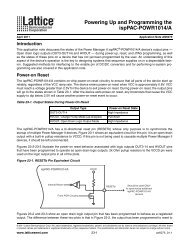DS1036 - Platform Manager Data Sheet - Lattice Semiconductor
DS1036 - Platform Manager Data Sheet - Lattice Semiconductor
DS1036 - Platform Manager Data Sheet - Lattice Semiconductor
Create successful ePaper yourself
Turn your PDF publications into a flip-book with our unique Google optimized e-Paper software.
Figure 47. PIO Block Diagram<br />
sysIO Buffer<br />
From Routing<br />
From Routing<br />
62<br />
<strong>Platform</strong> <strong>Manager</strong> <strong>Data</strong> <strong>Sheet</strong><br />
Each I/O is associated with a flexible buffer referred to as a sysIO buffer. These buffers are arranged around the<br />
periphery of the device in groups referred to as banks. The sysIO buffers allow users to implement the wide variety<br />
of standards that are found in today’s systems including LVCMOS, TTL, BLVDS, LVDS and LVPECL.<br />
FPGA output buffers and ratioed input buffers (LVTTL and LVCMOS) are powered using V CCIO . In addition to the bank<br />
V CCIO supplies, the FPGA fabric has a V CC core logic power supply, and a V CCAUX supply that powers up a variety of<br />
internal circuits.<br />
Top and Bottom sysIO Buffer Pairs<br />
The sysIO buffer pairs in the top and bottom banks of the device consist of two single-ended output drivers and two<br />
sets of single-ended input buffers (for ratioed or absolute input levels). The I/O pairs on the top and bottom of the<br />
devices also support differential input buffers.<br />
Left and Right sysIO Buffer Pairs<br />
Fast Output<br />
<strong>Data</strong> signal DO<br />
Input<br />
<strong>Data</strong> Signal<br />
Note: Buffer 1 tracks with VCCAUX Buffer 2 tracks with VCCIO. Buffer 3 tracks with internal 1.2V VREF .<br />
The sysIO buffer pairs in the left and right banks of the device consist of two single-ended output drivers and two<br />
sets of single-ended input buffers (supporting ratioed and absolute input levels). The devices also have a differential<br />
driver per output pair. The referenced input buffer can also be configured as a differential input buffer. In these<br />
banks the two pads in the pair are described as “true” and “comp”, where the true pad is associated with the positive<br />
side of the differential I/O, and the comp (complementary) pad is associated with the negative side of the differential<br />
I/O.<br />
Typical I/O Behavior During Power-up<br />
Programmable<br />
Delay Elements<br />
The internal power-on-reset (POR) signal is deactivated when V CC and V CCAUX have reached satisfactory levels.<br />
After the POR signal is deactivated, the FPGA core logic becomes active. It is the user’s responsibility to ensure<br />
that all V CCIO banks are active with valid input logic levels to properly control the output logic states of all the I/O<br />
TS<br />
sysIO<br />
Buffer<br />
1<br />
2<br />
3<br />
TO<br />
PAD









